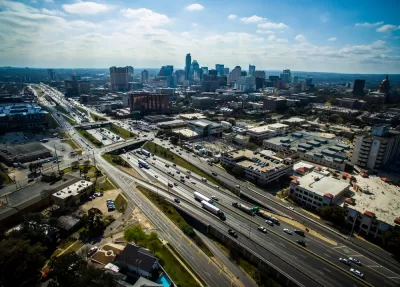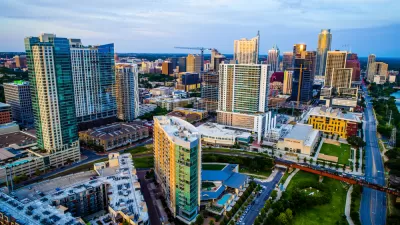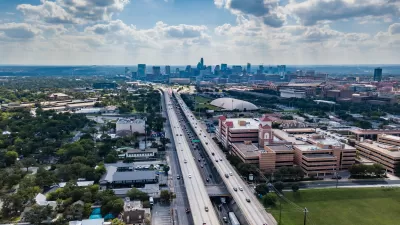After releasing "public scoping" details for a massive widening project in Downtown Austin, a writer slams the Texas Department of Transportation for its car-centric approach to transportation planning.

James Rambin reports that the Texas Department of Transportation has released new details of a plan to widen the I-35 Capital Express project to add capacity along eight miles of the freeway between US 290 East and SH 71/Ben White Boulevard. The "public scoping" presentation is available on YouTube, and linked above.
Rambin, who is explicitly critical of the TxDOT's proclivity for widening already massive public highways, notes that the first two design options shown in the video would bring the total number of lanes on I-35 to 20—up from the current 12 lanes. The article includes numerous cross sections to show what that many lanes would look like in reality.
Other than the massive size of the proposed expansion, Rambin says the plan currently has revealed very few details. With the possibility for bus rapid transit, light rail (via Project Connect), or toll lanes to be included in the project, TxDOT is clearly looking a different direction, however. Rambin explains:
The single major adaptation shown in these presentations are each design’s potentially grade-separated or tunneled HOV lanes, which might relieve gridlock slightly — but don’t overlook that the most effective high-occupancy lanes integrate congestion pricing in what’s known as an express HOT lane, and the state government under Gov. Greg Abbott has made it very clear in recent years that tolls are not an option here.
Among the criticisms expressed by Rambin: that the I-35 project would represent a generational failure if built as proposed in this presentation.
FULL STORY: Widening I-35 to 20 Lanes in Downtown Austin is the Anti-Project Connect

Alabama: Trump Terminates Settlements for Black Communities Harmed By Raw Sewage
Trump deemed the landmark civil rights agreement “illegal DEI and environmental justice policy.”

Planetizen Federal Action Tracker
A weekly monitor of how Trump’s orders and actions are impacting planners and planning in America.

The 120 Year Old Tiny Home Villages That Sheltered San Francisco’s Earthquake Refugees
More than a century ago, San Francisco mobilized to house thousands of residents displaced by the 1906 earthquake. Could their strategy offer a model for the present?

Ken Jennings Launches Transit Web Series
The Jeopardy champ wants you to ride public transit.

BLM To Rescind Public Lands Rule
The change will downgrade conservation, once again putting federal land at risk for mining and other extractive uses.

Indy Neighborhood Group Builds Temporary Multi-Use Path
Community members, aided in part by funding from the city, repurposed a vehicle lane to create a protected bike and pedestrian path for the summer season.
Urban Design for Planners 1: Software Tools
This six-course series explores essential urban design concepts using open source software and equips planners with the tools they need to participate fully in the urban design process.
Planning for Universal Design
Learn the tools for implementing Universal Design in planning regulations.
Clanton & Associates, Inc.
Jessamine County Fiscal Court
Institute for Housing and Urban Development Studies (IHS)
City of Grandview
Harvard GSD Executive Education
Toledo-Lucas County Plan Commissions
Salt Lake City
NYU Wagner Graduate School of Public Service





























